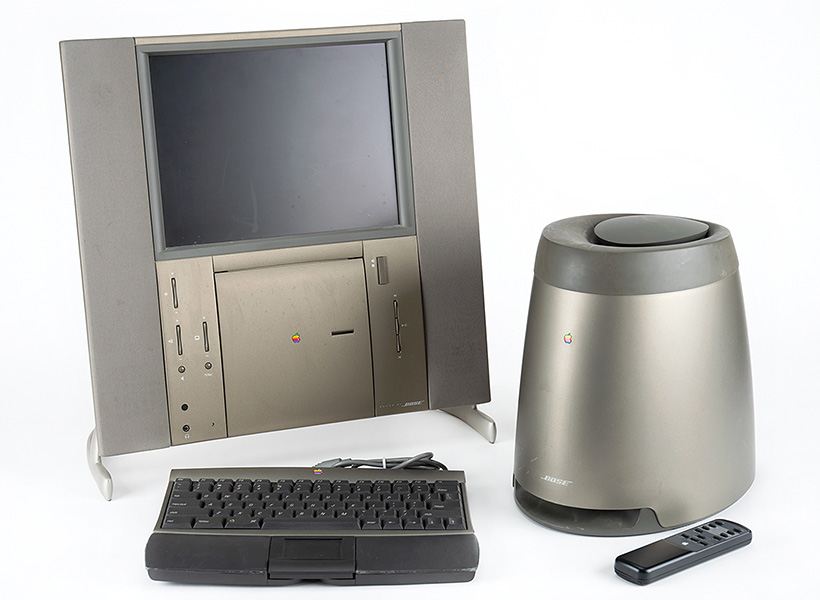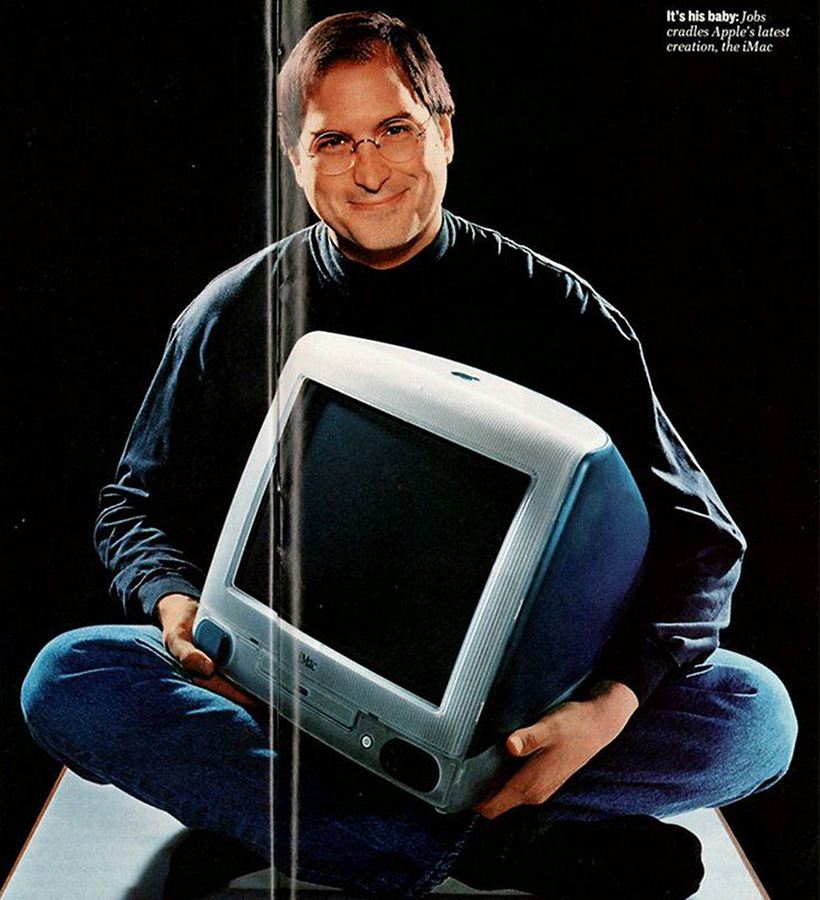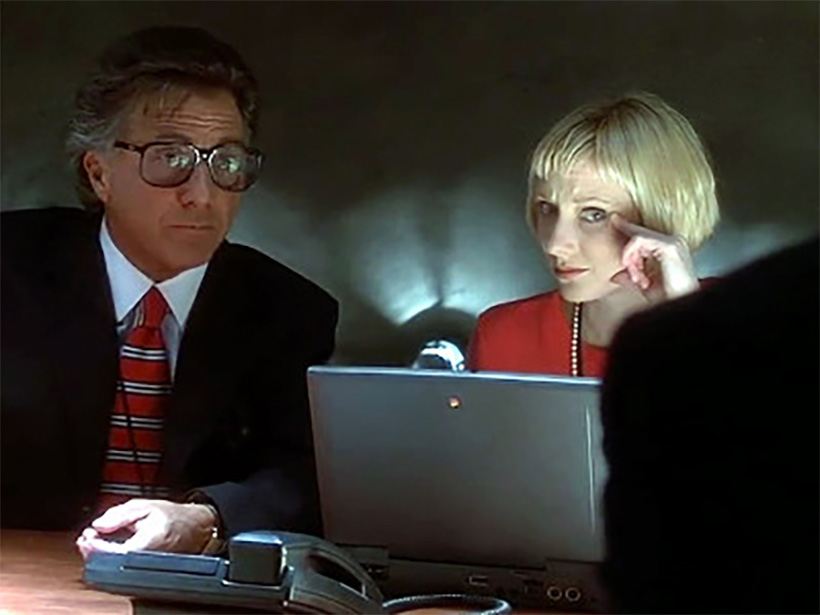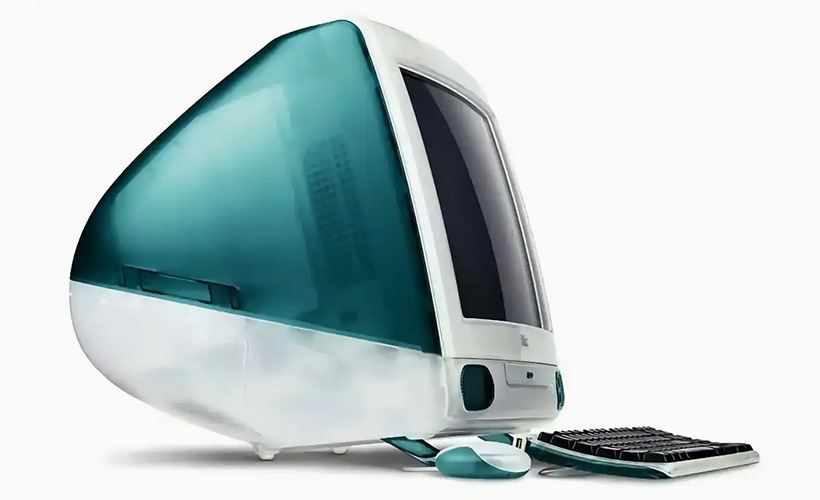History of Apple 1997-1998 – Most Significant Events
In July 1997, Apple announces the resignation of Gil Amelio, following another multi-million dollar quarterly loss. The time and place for the most ground breaking announcements, however, would be MacWorld Boston in August 1997. Jobs, who by now was being referred to as “interim CEO,” makes the keynote speech, and speaks of the company’s upcoming aggressive advertising campaign, upcoming new Macs, and Rhapsody. He announces an almost entirely new Board of Directors, including Larry Ellison, CEO of Oracle. But he saves the best for last. In a ground breaking decision, Jobs announces an alliance of Apple Computer with Microsoft. In 1997, Apple Computer Inc. creates a new advertising slogan: Think different. Indeed, it is not easy to think outside of the box, but it is worth trying. Much later, in an interview with Peter Burrows in Bloomberg Businessweek, in 2004, Steve Jobs will say: “We, Apple, do things where we feel we can make a significant contribution. That’s one of my other beliefs”.
Contents
The History of Apple (1976-2016) [Video]
Video uploaded by Nobel Tech on May 2, 2016.
History of Apple 1997

January 7, 1997: At the Macworld Expo, Steven Jobs and Stephen Wozniak appear together on stage for the first time since 1984. Apple Computer announces it plans to release an operating system code-named Rhapsody in 1998 that will run current applications, Next OS applications, and Java applications. The new OS will feature preemptive multitasking and protected memory. Apple demonstrates a limited edition 20th anniversary Macintosh, featuring a flat-panel display, to be sold for US$9000.
January 1997: Apple releases the Mac OS 7.6 operating system. Code-name during development was Harmony. Upgrade price from System 7.5 is US$69, upgrade price from earlier operating systems is US$129.
January 1997: Apple Computer CEO Gilbert Amelio says Apple may drop the Newton line of handheld computers.
January 1997: Apple releases the Macintosh Java Runtime, a free Web site download.
February 4, 1997: Apple Computer’s acquisition of NeXT Software is complete. Total cost is $427 million.
February 1997: Apple Computer CEO Gilbert Amelio announces restructuring of the company to focus on the Mac OS and Macintosh hardware. Steve Jobs and Steve Wozniak will join the executive committee as advisers to Amelio.
February 1997: Apple Computer completes its acquisition of Next Software, for a total cost of US$430 million.
February 16, 1997: The Fox Broadcasting Company airs The Simpsons TV show episode, where in the title scene, an Apple Computer Macintosh-style window makes a parody of the America Online software, calling it America Onlink, with a very slow loading of artwork for the show’s family characters.
February 17, 1997: Apple unveils many updated desktop and portable Macintosh computers: PowerBook 3400 and 4400, and Power Macintosh 7300, 8600, and 9600. On the same occasion Apple Computer unveils the eMate handheld computer which weighs 8 pounds. Apple also introduces the Newton MessagePad 2000. It features 32-bit StrongARM 162 MHz processor and 5 MB RAM.
March 14, 1997: Apple Computer terminates 2700 of 11,000 full-time positions, and 1400 contract or temporary positions. The OpenDoc and Open Transport projects are dropped, as is the Performa brand name.
March 19, 1997: Apple unveils the 20th Anniversary Macintosh computer. It features flat-panel metal and leather design, television and FM radio tuners, special sound system with subwoofer, 12.1-inch active-matrix display, CD-ROM drive. Production will be limited to 12,000 units, in five countries: France, Germany, Japan, United Kingdom, and the United States. Price is US$7,500.
March 24, 1997: Apple ships the MessagePad 2000 for $949 with lots of software, 16 grayscale screen, 160MHz StrongARM processor, audio recording capability, backlit rotating screen.
March 24, 1997: Apple Computer releases the Apple eMate 300. It features 25MHz ARM 710a processor, 3 MB RAM, 480 x 320 pixel backlit grayscale screen, Newton 2.1 operating system. Price is US$799.
April 4, 1997: Apple Computer introduces new Power Macintosh 6500 systems, with 225 to 300 MHz PowerPC 603e processors. Prices range from US$1999 to US$2999.
April 7, 1997: Apple Computer ships Mac OS 7.6.1.
April 17, 1997: Apple Computer reports a first quarter loss of $740 million, largest quarter loss ever for a Silicon Valley company.
May 8, 1997: Apple Computer introduces the PowerBook 2400c notebook computer. It features 180 MHz PowerPC 603e processor, 1.3 GB hard drive, 10.4-inch active-matrix color display, two PC Card slots. Weight is 4.4 pounds; price is to be about US$3500. Availability is end of May in Japan, and end of July in the US.
May 25, 1997: Apple Computer announces that it will make its Newton Systems Group a subsidiary company, to market the MessagePad 2000 and eMate 3000, with about 130 Apple employees.
May 27, 1997: Apple Computer and its Mac OS licensees agree to change Apple Computer’s Macintosh OS fee from about US$50 to US$150-350 per system, depending on processor speed.
May 1997: Apple Computer ships the Twentieth Anniversary Mac, featuring active-matrix LCD color screen, 250MHz PowerPC 603e processor, 4x CD-ROM drive, 32 MB RAM, Bose Accoustimass sound system, in-home setup service, for $7500. Borrowing from the 1997 Twentieth Anniversary Macintosh, the various LCD-based iMac designs will continued the all-in-one concept first envisioned in Apple’s original Macintosh computer. The successful iMac will allow Apple to continue targeting the Power Macintosh line at the high-end of the market.
June 26, 1997: Steve Jobs sells 1.5 million shares of Apple Computer stock for about $15 per share, total $15-22 million. This is the stock that he received in December as part of Apple Computer’s purchase of his NeXT Software. The value of Apple Computer’s stock drops to an 11-year low.
April-June 1997: Market share of personal computer in the world for April to June: Apple Computer 3.8%.
July 9 1997: Apple announces the resignation of Gil Amelio as CEO, following another multi-million dollar quarterly loss. His severance package is about US$7.5 million. Ellen Hancock also resigns from Apple Computer. These decisions came as a surprise to nearly everyone, and at this time a new CEO has yet to be announced. The Executive Board felt that Amelio had done all he could for Apple, and that while he had been responsible for a number of improvements at Apple, he could do no more. In the meantime Fred Anderson, Apple’s CFO, has been put in charge of day-to-day operation, and Steve Jobs was given an expanded role at Apple for the interim.
July 22, 1997: Apple announces Mac OS 8.0 and releases it on July 26, 1997 for US$99. Code-name during development was Tempo. 1.2 million copies will be shipped in the first two weeks, making it the most successful Apple software product ever.
July 1997: Steve Jobs decides to not take on the role of chairman (and CEO) of Apple Computer, preferring to remain as head of Pixar Animation Studios.
August 5, 1997: Steve Jobs makes the keynote speech at the Macworld Expo in Boston, and speaks of the company’s upcoming aggressive advertising campaign, upcoming new Macs, and Rhapsody.
August 5, 1997: at the Macworld Expo trade show in Boston, Massachusettes, Apple Computer announces Power Macintosh 8600 and 9600 systems with 300 to 350 MHz PowerPC 604e processors and Mac OS 8 operating system. Prices range from US$3700 to US$5400.
August 6, 1997: At the Macworld Expo, Steve Jobs and Bill Gates announce a five-year alliance of Apple Computer with Microsoft. Terms include: cross-licensing of existing patents plus new patents over the next five years, Microsoft will release Office for Macintosh over next five years, Apple will make Internet Explorer the default browser on all shipping Macintosh systems, Apple and Microsoft will collaborate on Java compatibility, Microsoft will invest US$150 million in Apple stock and hold it for at least three years. Jobs will join a revamped Apple board of directors with Larry Elison of Oracle added, and A.C. Markkula removed.
August 7, 1997: At Macworld Expo, Motorola announces the StarMax 6000 Macintosh-compatible systems, with PowerPC 750 processors.
August 7, 1997: At Macworld Expo, Power Computing introduces the PowerTower Pro G3/275 Macintosh-compatible computer. It features 275 MHz PowerPC 750, 64 MB RAM, 2-4 GB hard drive, and 8 MB 1XMicro TwinTurbo graphics card.
August 1997: Steve Jobs begins designing what will become the iMac.

August 1997: The US Department of Justice begins a review of Microsoft’s investment in Apple Computer (see August 6, 1997).
September 2, 1997: Apple announces its intention to buy out Power Computing’s MacOs licence, as Steve Jobs was sure that clone vendors such as Power Computing were cutting into Apple’s high-end market, where they traditionally made the most profit. Clones had failed to effectively expand the MacOS market, instead taking customers away from Apple. Apple also offered jobs to many of Power Computing engineering staff. Power went out of business several months later. Apple also bought out its MacOS licences from Motorola and IBM, but Umax was allowed to stay in the game, but with the tacit understanding that it would fill the low-end market, with machines selling for under $1000. Umax sold its remaining inventory of Macs, and became selling Wintel boxes. Apple Computer buys Power Computing’s Macintosh operating system license, customer database, and certain employees, for US$100 million in common stock and about $10 million for debts and closing costs. Power Computing will cease sales of Macintosh systems as of December 31.
September 8, 1997: Umax Computer announces that it has reached an agreement with Apple Computer for an extension on its license on the Mac OS 8 operating system. The license only covers Mac OS 8 until July 1998, and not on Common Hardware Reference Platform architecture machines.
September 9, 1997: Apple Computer announces it will not spin off its Newton Systems Group as it had announced in May.
September 11, 1997: Motorola Computer Group announces it is leaving the Macintosh systems market, due to inability to reach a viable business agreement with Apple Computer on licensing the Mac OS. Motorola also announces it will not ship StarMax 6000 systems previously announced.
September 15, 1997: Apple Computer announces several Power Macintosh 6500 systems with 275 to 300 MHz PowerPC 603e processors, and the Mac OS 8 operating system.
September 16, 1997: Apple Computer announces that it has named Steve Jobs interim CEO of the company.
September 29б 1997: Umax Computer unveils the J700 Macintosh-compatible computer. It features Mac OS 8, 233 MHz PowerPC 604e processor, 24 MB RAM, 2 GB hard drive, 24X CD-ROM drive, 10 Base-T Ethernet networking card. Price is about US$2000.
July-September 1997: Market share of personal computers in the world for July to September: Apple Computer 3.3%.
September 1997: Apple Computer ships a beta test copy of its “Rhapsody” operating system to developers.
October 20, 1997: Apple Computer introduces the MessagePad 2100 handheld computer. It features Newton 2.1 operating system, 4.9 x 3.3 inch 480 x 320 pixel 16-shade grayscale LCD display, 4 MB RAM, stylus, two Type-II PC Card slots, four AA batteries. Size is 8.3 x 4.7 x 1.1 inches; weight is 1.4 pounds; price is US$999.
November 1997: Apple Computer introduces the Apple MessagePad 2100 handheld computer. It features Newton 2.1 OS, 8 MB ROM with various applications, 4 MB DRAM, 4 MB flash RAM, optional 2-4 MB flash PC Cards, two Type II PC Card slots, 16-shade 4.9 x 3.3 inch display, four AA batteries, and a stylus. Weight is 22.4 ounces; size is 1.1 x 4.7 x 8.3 inches; price is about US$1150.
November 3, 1997: Umax Computer introduces the C500/240 Macintosh-compatible computer. It features 240 MHz PowerPC 603e, 3 GB hard drive, 24 MB RAM, CD-ROM. Price is US$1295.
November 4, 1997: Apple Computer announces a deal with CompUSA for a “store within a store” for Apple products in all 148 retail locations.
November 10, 1997: Apple Computer introduces the Power Macintosh G3 computer. It features 233 or 266 MHz PowerPC 750 processor, 66 MHz system bus, 4 GB hard drive, 32 MB SDRAM, 512 kB cache, 24X CD-ROM drive. Price starts at US$1999. Apple also releases the PowberBook G3.
November 10, 1997: Steven Jobs announces further changes to Apple’s corporate strategy. Apple would now sell computers direct, both over the web and the phone, as Power Computing had done so well in the past.
December 1997: Market share of personal computers in the US during October to December: Compaq Computer 19%, Dell Computer 9.9%, Gateway 8.3%, IBM 9.9%, Hewlett-Packard 6.8%, Apple Computer 3.4%. Personal computer market share in Canada based on sales for the year: Compaq 19.8%, IBM 16.0%, Dell 7.4%, Hewlett-Packard 4.8%, Toshiba 4.4%, Packard Bell NEC 4.4%, Apple Computer 4.1%, Seanix 3.0%, Sidus 2.5%. Worldwide non-Apple personal computer market share: Compaq Computer 12%, IBM 9%, Packard Bell/NEC 5%, Dell Computer 6%, Hewlett-Packard 5%. Market share of home personal computers in the US for the year: Packard Bell NEC 23.3%, Compaq Computer 18.8%, Gateway 11.1%, IBM 7.0%, Acer 5.9%, Apple Computer 5.0%, other 28.9%. During the year, 94.5% of personal computers and workstations were shipped with a Microsoft operating system.
History of Apple 1998

January 9, 1998: New Line Cinema releases the film Wag the Dog. An Apple PowerBook Duo 280c laptop computer appears in a close-up.
January 27, 1998: Apple Computer shifts development and distribution of ClarisWorks from Claris back to Apple, and renames it AppleWorks. Claris is renamed FileMaker, with primary focus the FileMaker Pro software. 30 Claris employees are laid off.
January, 1998: At MacWorld San Francisco Jobs announces that Apple had, for the first time in more than a year, had a profitable quarter, to the tune of $44 Million. This far eclipsed analysts’ projections, and sent Apple’s stock back into the 20s.
February 1998: Apple Computer releases QuickTime 3.0 for the Macintosh.
February 1998: Sales of Apple Computer’s MacOS 8 to date: over 2 million. Apple Computer reduces the price of the 20th Anniversary Macintosh to US$3999 to sell out remaining units.
February 1998: Apple releases the MacOS 8.1 operating system.
February 27, 1998: Apple Computer ceases development of its Newton operating system and Newton OS-based products.
March 1998: Apple Computer and Microsoft announces they will merge their two Java implementations into one Mac OS Runtime for Java.
March 1998: In New York City, New York, the Seybold conference is held. Apple Computer’s Steve Jobs unveils the 300 MHz Power Macintosh G3, demonstrates a 400 MHz G3 processor with copper wiring, and 15.1-inch Apple Studio Display desktop LCD screen.
April 1998: Apple announces another profitable quarter – $57 Million, which comes as a big surprise to nearly everyone.
May 1998: At the Apple Worldwide Developers Conference, Apple Computer announces it has licensed Symantec’s just-in-time Java compiler for integration into the Mac OS Runtime for Java. Apple also announces a new operating strategy, combining work on Rhapsody with the current Mac OS, under new name Mac OS X.
May 1997: Microsoft introduces the IntelliMouse Pro mouse. Price is US$70.
May 1998: Operating system desktop market share: Windows 95 62.9%, Windows 3.x 17.4%, Mac OS 5.6%, DOS 3.9%, Windows NT workstation 3.0%, others 7.2%.
May 1998: Umax abandons the Macintosh-compatible market.
May 6, 1998: At the Flint Center Theater, Steve Jobs introduces the Apple Computer iMac computer. It features 233 MHz PowerPC G3 processor, 512 kB backside cache, 32 MB RAM, 4 GB EIDE hard disk, ATI Rage IIc with 2 MB SGRAM video, 15-inch built-in monitor, 66 MHz PCI system bus, 10/100 BaseT Ethernet, IrDA infrared port, 33.6 kbps modem, two USB ports, 24X CD-ROM drive, and Bondi Blue case. Price is US$1299. About 6 million iMacs will be sold in the next four years.
May 6, 1998: Apple Computer introduces the Macintosh PowerBook G3 portable computer. It features 233 to 292 MHz PowerPC 750 processor, 12.3-14.1-inch TFT display, 0-1 MB Level 2 cache, 32-192 MB SDRAM, 2-4 MB SGRAM video memory, 2-8 GB IDE hard drive, 20X CD-ROM drive, floppy drive, 10Base-T Ethernet, ATI Rage LT video controller, 16 bit stereo sound, 32-bit CardBus interface, external VGA output. Size if 12.7 x 10.4 x 2 inches; weight is about 7 pounds. The system runs for about three hours on lithium-ion batteries. Systems are custom built to customer specifications. This is the first Apple computer with new solid-colored Apple logo.
May 6, 1998: Apple Computer annonces its Educational Apple Store, and an entirely new Mac design–the iMac.
May 11, 1998: Apple Computer announces that 1 million copies of QuickTime 3.0 have been downloaded from its Web site.
July 1998 : Apple profits for the 3rd consecutive quarter, to the tune of $101 million. This helps to push Apple’s stock to several 52-week highs in just a few days.

August 15, 1998: Apple Computer begins shipping the iMac to retail outlets in the US. Price is US$1299. (278,000 units are shipped in the first six weeks.)
August 28, 1997: Apple Computer releases the iMac in Japan. Price is 178,000 yen (US$1227).
September 21, 1997: Apple Computer releases the AppleWorks 5 software suite. Price is US$99; upgrade price is US$79.
September 30, 1997: Mac announces that unit sales of iMac systems during the first six weeks of availability are of 278,000. This is the fastest shipping Macintosh to date.
October 14, 1998: Apple Computer introduces the Mac OS 8.5 operating system. Release date is set for October 17. Price is US$99.
December 11, 1998: Warner Bros. Pictures releases the film You’ve Got Mail. The title is the phrase used by the America Online software, which is shown and used in the film. The icon for Microsoft Word appears on a computer desktop. An Apple Powerbook and an IBM laptop computer are used throughout the film.
December 1998: a 5th consecutive profitable quarter for Apple computer. The iMac was the best-selling computer in the nation for most of the fall. It drives Apple sales well beyond most predictions, with year-over-year growth, and a sleek new PowerMac G3.
December 1998: Market share of personal computers in the USA during October to December: Compaq Computer 18.1%, Dell Computer 12.8%, Gateway 9.1%, IBM 9.1%, Hewlett-Packard 7.2%, Apple Computer 4.5%. Personal computer market share in Canada based on sales for the year: Compaq 21.5%, IBM 19.6%, Dell 10.2%, Hewlett-Packard 7.0%, Toshiba 4.7%, Apple Computer 4.0%, Packard Bell NEC 3.3%, Seanix 2.8%, Acer 1.6%, Sidus 1.5%. Market share of personal computer shipments in the US during the year: Dell Computer 13.2%, Compaq Computer 16.7%, Gateway 8.4%, Hewlett-Packard 7.8%, Apple Computer 4.6%. Market share of desktop personal computer operating systems in the USA during the year: Windows 95 57.4%, Windows 98 17.2%, Windows NT 11%, Mac OS 5%, DOS 3.8%, Linux 2.1%, Windows 3.11 1.1%, Unix 0.8%, OS/2 0.5%, others 1%. Shipments of Apple Computer iMac computers worldwide during the year: 800,000.
Bibliography
- “iWoz: Computer Geek to Cult Icon: How I Invented the Personal Computer, Co-Founded Apple, and Had Fun Doing It” by Steve Wozniak and Gina Smith
- “Steve Jobs” by Walter Isaacson
Links
- Chronology of Personal Computers
- Apple History
- History of Apple: 1970-1989 – Most Significant Events – iGotOffer Apple Encyclopedia
- History of Apple: 1990-1992 – Most Significant Events – iGotOffer Apple Encyclopedia
- History of Apple: 1993–1994 – Most Significant Events – iGotOffer Apple Encyclopedia
- Sell your old Apple computer online – iGotOffer
- News and Reviews About Electronic Gadgets and Apps – iGotOffer Blog

Thanks. Will you go on publishing new timeline stories? (what I can see is the Second Quarter 2019).
Thank you for asking. Yes we’ll certainly will follow what Apple does and publish its history. Be patient.